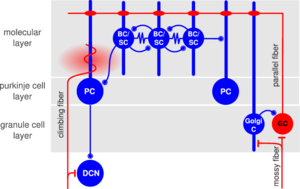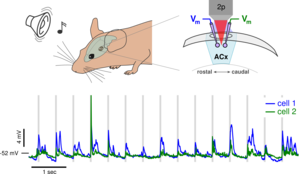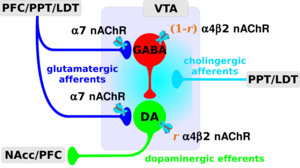My research interests involve projects combining experimental and computational approaches in Neuroscience.
Interneuron networks in the Cerebellum
with Isabel Llano

|
|
Fig 1. Microcircuitry of the cerebellum.
|
Feedforward inhibitory microcircuits, in which interneurons and their target principal cells receive common excitatory inputs, are abundant in the brain and have been shown to regulate neuronal excitability and temporal integration. However, their role in sensory information processing remains poorly understood. The cerebellum is an ideal place to study the role of feedforward inhibition due to its modular organization and principal feedforward architecture and its involvement in the timing and coordination of movements. We are investigating the molecular layer interneuron network and its control of Purkinje cells activity - the output cells of the cerebellum - through feedforward inhibition. The properties and the role of this interaction in the behaving animal remains unknown. Our goal is to shed light on the activity patterns occurring in and the functional role of the interneuron network for Purkinje cell firing
in vivo through a combination of calcium imaging, electrophysiological recordings and modeling of the molecular layer microcircuit.
Synaptic input and membrane potential correlations in the auditory cortex
with Erik Nylen and Alex D. Reyes

|
|
Fig 2. Paired whole-cell recordings in the mouse auditory cortex.
|
Correlations in the spiking activities between neurons exist throughout cortex and have been observed under a variety of experimental conditions. In the auditory cortex, correlations may develop during acoustic stimulation (signal correlations) but may also be stimulus independent (noise correlations), arising instead from e.g. common synaptic inputs or global activity modulations. We investigate the noise and signal correlations in the subthreshold membrane potentials, which give rise to spike correlations, of neurons in auditory cortex during tone presentations and spontaneous activity. Using two-photon microscopy, we perform simultaneous in vivo whole-cell recordings from pairs of cells in layer 2/3 of the auditory cortex of anethetized mice. Whole cell recordings were established in two cells using the two-photon targeted patching technique.
Cellular and network mechanisms of nicotine action in the midbrain
with Boris Gutkin

|
|
Fig 3. Afferent inputs and circuitry of the ventral tegmental area.
|
Nicotine exerts its reinforcing action by stimulating nicotinic acetylcholine receptors (AChRs) and boosting dopamine (DA) output from the ventral tegmental area (VTA). Recent data have led to a debate about the principal pathway of nicotine action: direct stimulation of the DAergic cells through nAChR activation, or disinhibition mediated through desensitization of nAChRs on GABAergic interneurons. We use a computational model of the VTA circuitry and nAChR function to shed light on this issue. Our model illustrates that the α4β2-containing nAChRs either on DA or GABA cells can mediate the acute effects of nicotine. We account for
in vitro as well as
in vivo data, and predict the conditions necessary for either direct stimulation or disinhibition to be at the origin of DA activity increases. We propose key experiments to disentangle the contribution of both mechanisms. We show that the rate of endogenous acetylcholine input crucially determines the evoked DA response for both mechanisms.
Biophysical processes underlying synaptic plasticity and natural firing patterns
with Pascal Wallisch and Srdjan Ostojic

|
|
Fig 3. Two connected neurons are made to fire irregular spike-pairs with fixed time lag. Correlation diagram on the right.
|
Synaptic plasticity is sensitive to both the rate and the timing of pre- and post-synaptic spikes. In experimental protocols used to induce plasticity, the imposed spike trains are typically regular and the relative timing between every pre- and postsynaptic spike is fixed. This is at odds with natural firing patterns observed in the cortex of intact animals, where cells fire irregularly and the timing between pre- and post-synaptic spikes varies. To investigate synaptic changes elicited by in vivo-like irregular firing at different rates and realistic correlations between pre- and post-synaptic spikes, we use numerical simulations and mathematical analysis of synaptic plasticity models fitted to experimental data.



